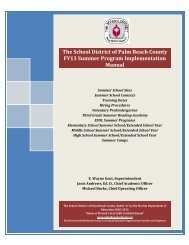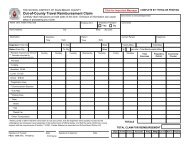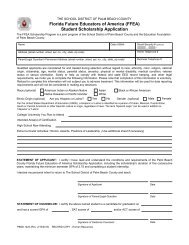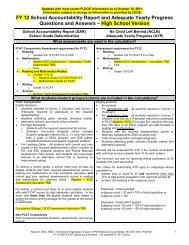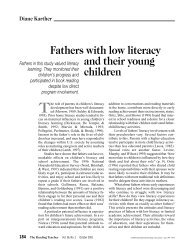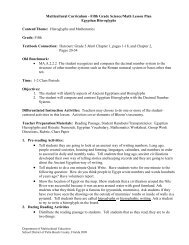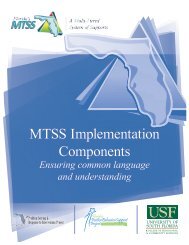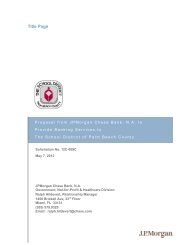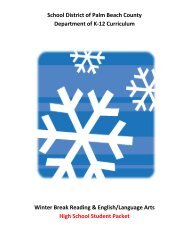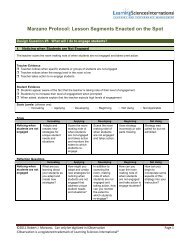Assessment (ESOL Testing and Evaluation) - The School District of ...
Assessment (ESOL Testing and Evaluation) - The School District of ...
Assessment (ESOL Testing and Evaluation) - The School District of ...
You also want an ePaper? Increase the reach of your titles
YUMPU automatically turns print PDFs into web optimized ePapers that Google loves.
PROFESSIONAL LEARNING INSERVICE COMPONENT INFORMATION<br />
COMPONENT TITLE:<br />
<strong>Assessment</strong> (<strong>ESOL</strong> <strong>Testing</strong> <strong>and</strong> <strong>Evaluation</strong>)<br />
IDENTIFIER NUMBER: 4701001<br />
MAXIMUM POINTS: 60<br />
RESTRICTED:<br />
This component is restricted <strong>and</strong> may only be opened by the Department <strong>of</strong> Multicultural<br />
Education.<br />
GENERAL OBJECTIVE:<br />
<strong>Assessment</strong> is an extensive range <strong>of</strong> actions used to obtain information about students’<br />
knowledge <strong>and</strong> skills. Considering the cultural <strong>and</strong> linguistic diversity <strong>of</strong> ELLs, appropriate<br />
assessment provides ways to demonstrate what they know <strong>and</strong> can do both in the English<br />
language <strong>and</strong> content areas.<br />
RESEARCH BASE:<br />
Training required by the META Consent Decree for teachers that work with the language<br />
development <strong>of</strong> ELLs. St<strong>and</strong>ards were developed with specific performance indicators. <strong>The</strong><br />
<strong>Assessment</strong> section is Domain 5. (http://www.fldoe.org/aala/rules.asp)<br />
SPECIFIC OBJECTIVES:<br />
Within the duration <strong>of</strong> the component, participants will:<br />
St<strong>and</strong>ard 1: <strong>Assessment</strong> Issues for ELLs<br />
Teachers will underst<strong>and</strong> <strong>and</strong> apply knowledge <strong>of</strong> assessment issues as they affect the<br />
learning <strong>of</strong> ELLs from diverse backgrounds <strong>and</strong> at varying English pr<strong>of</strong>iciency levels.<br />
Examples include cultural <strong>and</strong> linguistic bias; testing in two languages; sociopolitical <strong>and</strong><br />
psychological factors; special education testing <strong>and</strong> assessing giftedness; the importance<br />
<strong>of</strong> st<strong>and</strong>ards; the difference between formative <strong>and</strong> summative assessment; <strong>and</strong> the<br />
difference between language pr<strong>of</strong>iciency <strong>and</strong> other types <strong>of</strong> assessment (e.g.,<br />
st<strong>and</strong>ardized achievement tests). Teachers will also underst<strong>and</strong> issues around<br />
accountability. This includes the implications <strong>of</strong> st<strong>and</strong>ardized assessment as opposed to<br />
performance-based assessments, <strong>and</strong> issues <strong>of</strong> accommodations in formal testing<br />
situations. (20 points)<br />
Performance Indicators for St<strong>and</strong>ard 1:<br />
1. Demonstrate an underst<strong>and</strong>ing <strong>of</strong> the purposes <strong>of</strong> assessment as they relate to<br />
ELLs <strong>of</strong> diverse backgrounds <strong>and</strong> at varying English pr<strong>of</strong>iciency levels.<br />
2. Identify a variety <strong>of</strong> assessment procedures appropriate for ELLs <strong>of</strong> diverse<br />
backgrounds <strong>and</strong> at varying English pr<strong>of</strong>iciency levels.<br />
3. Demonstrate an underst<strong>and</strong>ing <strong>of</strong> appropriate <strong>and</strong> valid language <strong>and</strong> literacy<br />
assessments for ELLs <strong>of</strong> diverse backgrounds <strong>and</strong> at varying English pr<strong>of</strong>iciency<br />
levels.<br />
2010 – Multicultural Education
PROFESSIONAL LEARNING INSERVICE COMPONENT INFORMATION<br />
4. Demonstrate underst<strong>and</strong>ing <strong>of</strong> the advantages <strong>and</strong> limitations <strong>of</strong> assessments,<br />
including the array <strong>of</strong> accommodations allowed for ELLs <strong>of</strong> diverse backgrounds<br />
<strong>and</strong> at varying English pr<strong>of</strong>iciency levels.<br />
5. Distinguish among ELLs’ language differences, giftedness, <strong>and</strong> special education<br />
needs.<br />
St<strong>and</strong>ard 2: Language Pr<strong>of</strong>iciency <strong>Assessment</strong><br />
Teachers will appropriately use <strong>and</strong> interpret a variety <strong>of</strong> language pr<strong>of</strong>iciency<br />
assessment instruments to meet district, state, <strong>and</strong> federal guidelines, <strong>and</strong> to inform their<br />
instruction. Teachers will underst<strong>and</strong> their uses for identification, placement, <strong>and</strong><br />
demonstration <strong>of</strong> language growth <strong>of</strong> ELLs from diverse backgrounds <strong>and</strong> at varying<br />
English pr<strong>of</strong>iciency levels. Teachers will articulate the appropriateness <strong>of</strong> ELL<br />
assessments to stakeholders. (20 points)<br />
Performance Indicators for St<strong>and</strong>ard 2:<br />
1. Underst<strong>and</strong> <strong>and</strong> implement district, state, <strong>and</strong> federal requirements for<br />
identification, reclassification, <strong>and</strong> exit <strong>of</strong> ELLs from language support programs,<br />
including requirements <strong>of</strong> the LULAC Consent Decree.<br />
2. Identify <strong>and</strong> use a variety <strong>of</strong> assessment procedures for ELLs <strong>of</strong> diverse<br />
backgrounds <strong>and</strong> varying English pr<strong>of</strong>iciency levels.<br />
3. Use multiple sources <strong>of</strong> information to assess ELLs’ language <strong>and</strong> literacy skills<br />
<strong>and</strong> communicative competence.<br />
St<strong>and</strong>ard 3: Classroom-Based <strong>Assessment</strong> for ELLs<br />
Teachers will identify, develop, <strong>and</strong> use a variety <strong>of</strong> st<strong>and</strong>ards- <strong>and</strong> performance-based,<br />
formative <strong>and</strong> summative assessment tools <strong>and</strong> techniques to inform instruction <strong>and</strong><br />
assess student learning. Teachers will underst<strong>and</strong> their uses for identification, placement,<br />
<strong>and</strong> demonstration <strong>of</strong> language growth <strong>of</strong> ELLs from diverse backgrounds <strong>and</strong> at varying<br />
English pr<strong>of</strong>iciency levels. Teachers will articulate the appropriateness <strong>of</strong> ELL<br />
assessments to stakeholders. (20 points)<br />
Performance Indicators for St<strong>and</strong>ard 3:<br />
1. Use performance-based assessment tools <strong>and</strong> tasks that measure ELLs’ progress<br />
in English language <strong>and</strong> literacy development.<br />
2. Underst<strong>and</strong> <strong>and</strong> use criterion-referenced assessments appropriately with ELLs<br />
from diverse backgrounds <strong>and</strong> at varying English pr<strong>of</strong>iciency levels.<br />
3. Use various tools <strong>and</strong> techniques to assess content-area learning (e.g., math,<br />
science, social studies) for ELLs at varying levels <strong>of</strong> English language <strong>and</strong><br />
literacy development.<br />
4. Prepare ELLs to use self- <strong>and</strong> peer-assessment techniques, when appropriate.<br />
5. Assist ELLs in developing necessary test-taking skills.<br />
4. Assess ELLs’ language <strong>and</strong> literacy development in classroom settings using a<br />
variety <strong>of</strong> authentic assessments, e.g., portfolios, checklists, <strong>and</strong> rubrics.<br />
2010 – Multicultural Education
PROFESSIONAL LEARNING INSERVICE COMPONENT INFORMATION<br />
LEARNING STRATEGY/METHODOLOGY PROCEDURES:<br />
Participants will:<br />
1. Engage in presentations, discussions <strong>and</strong> other activities which help them master the<br />
identified competencies.<br />
2. View videos <strong>and</strong>/or educational televisions programming in order to master identified<br />
competencies.<br />
3. Work with the district pr<strong>of</strong>essional library, public, college or university libraries to<br />
complete independent research to apply to classroom instruction.<br />
EVALUATION OF PARTICIPANTS:<br />
Participants must demonstrate a mastery <strong>of</strong> the training content measured by producing products<br />
from their training that provide documentation <strong>of</strong> an underst<strong>and</strong>ing <strong>of</strong> the training. Participants<br />
will provide feedback regarding the format <strong>and</strong> delivery <strong>of</strong> the training by submitting a<br />
Participant Feedback survey to the instructor.<br />
IMPLEMENTATION ACTIVITIES:<br />
Participants will:<br />
1. Demonstrate ability to use instructional materials appropriate for ELL students using <strong>ESOL</strong><br />
strategies which enhance language learning <strong>and</strong> acquisition.<br />
2. Analyze appropriate assessment data to determine individual progress <strong>of</strong> ELL students in<br />
the classroom <strong>and</strong> on district/state assessment instruments.<br />
3. Demonstrate the ability to assess initial English language pr<strong>of</strong>iciency for placement <strong>and</strong><br />
instruction<br />
4. Identify <strong>and</strong>/or develop assessment instruments, rubrics <strong>and</strong> evaluation tools to determine<br />
the ability <strong>of</strong> students to function independently in regular classes for English speakers.<br />
5. Demonstrate the ability to assess limited English pr<strong>of</strong>icient (ELL) student's progress in<br />
the classroom using a variety <strong>of</strong> assessment instruments.<br />
COMPONENT EVALUATION:<br />
Pr<strong>of</strong>essional learning facilitator(s) will assess the degree to which the activities addressed the<br />
specific objectives <strong>and</strong> will make recommendation for revision through a component evaluation.<br />
2010 – Multicultural Education



